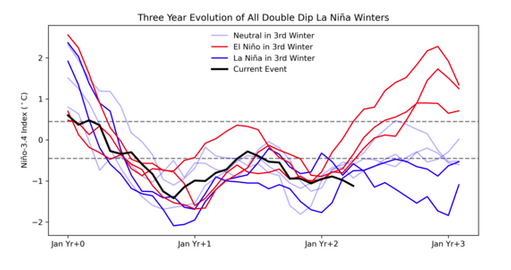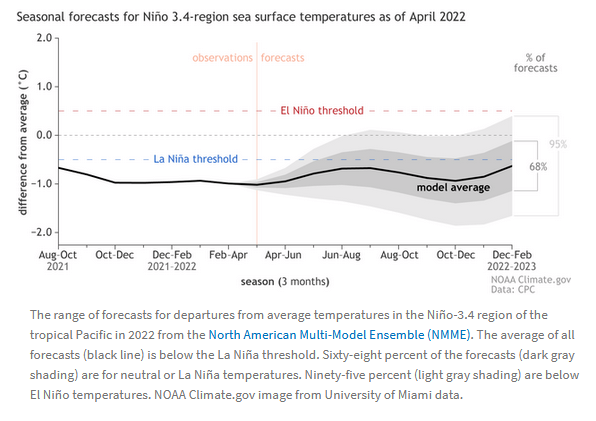On the second Thursday of every month, NOAA issues its analysis of the status of ENSO. This includes determining the Alert System Status. Although the current status remains the same i.e. La Nina Advisory, the forecast has been adjusted somewhat from last month. The forecast calls for the La Nina to continue. The timing is shown in the NOAA discussion and the IRI probability analysis. Of importance, the chances of a Triple Dip La Nina are still difficult to predict but seem to be slightly higher than the estimate last month. That would be a real disaster for the Southwest and the West Coast. The NOAA estimate for La Nina lasting into early Winter is 61%. This is a minority opinion in terms of other meteorological agencies almost all of which see La Nina ending sooner.
The impact of the NOAA forecast for the slow or non-existent transition from La Nina to ENSO Neutral will show up next Thursday when NOAA issues its Seasonal Outlook. The NOAA ENSO Status Update provides an advance indication of how the Outlook might change. There is a lag between the ENSO state and the impact on U.S. weather. Thus the exact strength of the La Nina may not be very important in terms of the actual impact on Summer weather including the North American Monsoon (NAM). We may see some changes farther out in the NOAA Outlook that will be issued next Thursday in particular Fall and Winter. Although the chances that this will happen are slightly less this month, the possibility of a Triple Dip should be of considerable concern. It most likely will be reflected in the Outlook issued next Thursday but perhaps not. We will learn more about what NOAA thinks next Thursday.

CLIMATE PREDICTION CENTER ENSO DISCUSSION
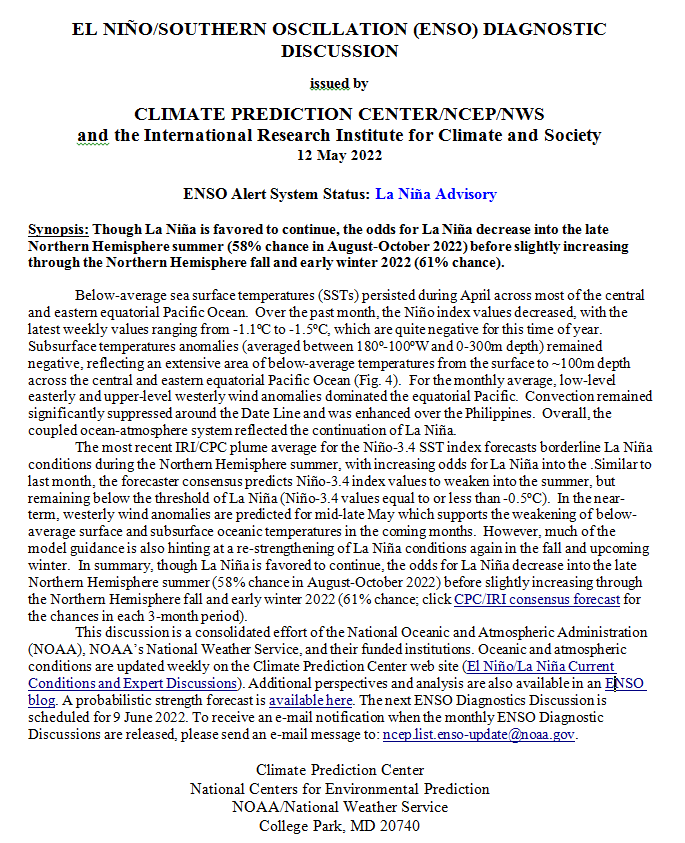
IRI CPC ENSO STATE Probability Distribution (IRI stands for the International Research Institute for Climate and Society)
Here are the new forecast probabilities. This information is released twice a month and the first release is based on a survey of Meteorologists. The probabilities are for three-month periods e.g. AMJ stands for April/May/June.
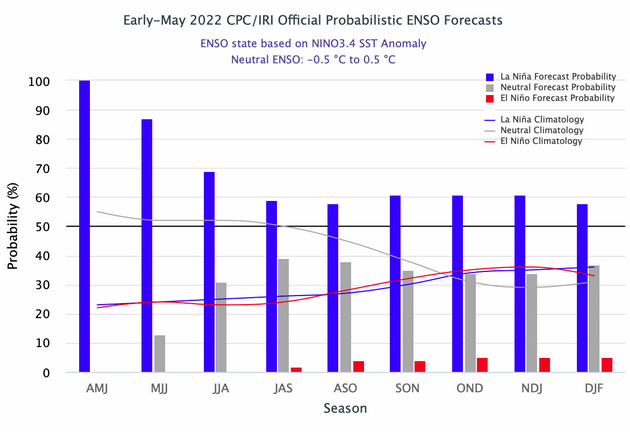
Here is the prior version issued in April
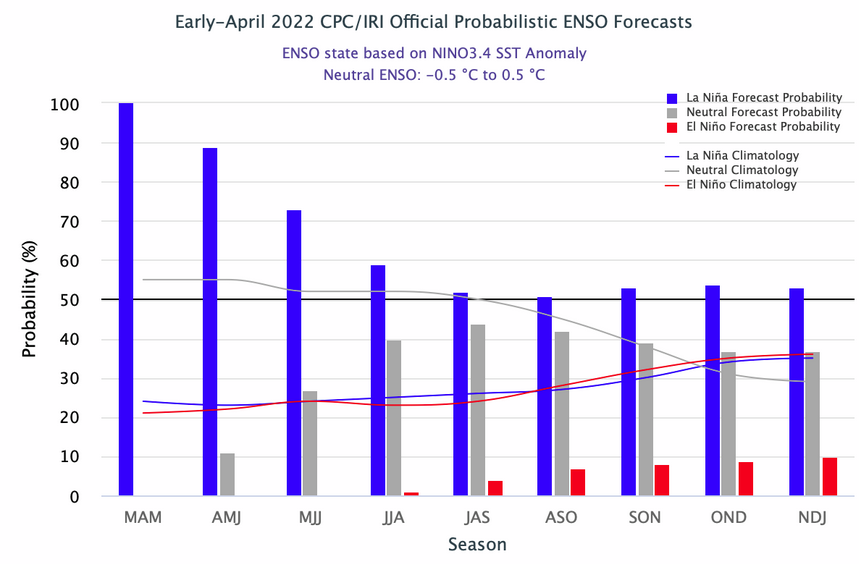
You would not know if from the NOAA discussion but the chances of a Three-peat are actually shown this month as higher than last month.
Prior Analysis
Sometimes it is useful to compare the current forecast to prior forecasts. IRI actually makes two forecasts a month. The first which is based on a survey of meteorologists is the one that NOAA relies on when they prepare their seasonal outlook. The second is a summary of the forecasts made by a set of computer models.
Here are three sets of those forecasts. For the first two, the initial forecast is also shown above. There is a pattern here. The chances of a Three-peat have increased each month and the survey of the meteorologists has routinely been more convinced than the computer models that La Nina will persist. A possible reason for that is that some of the computer models are statistical models and from a statistical perspective a Three-peat is highly unusual.



What Does the NOAA Proprietary ENSO Model Forecast?
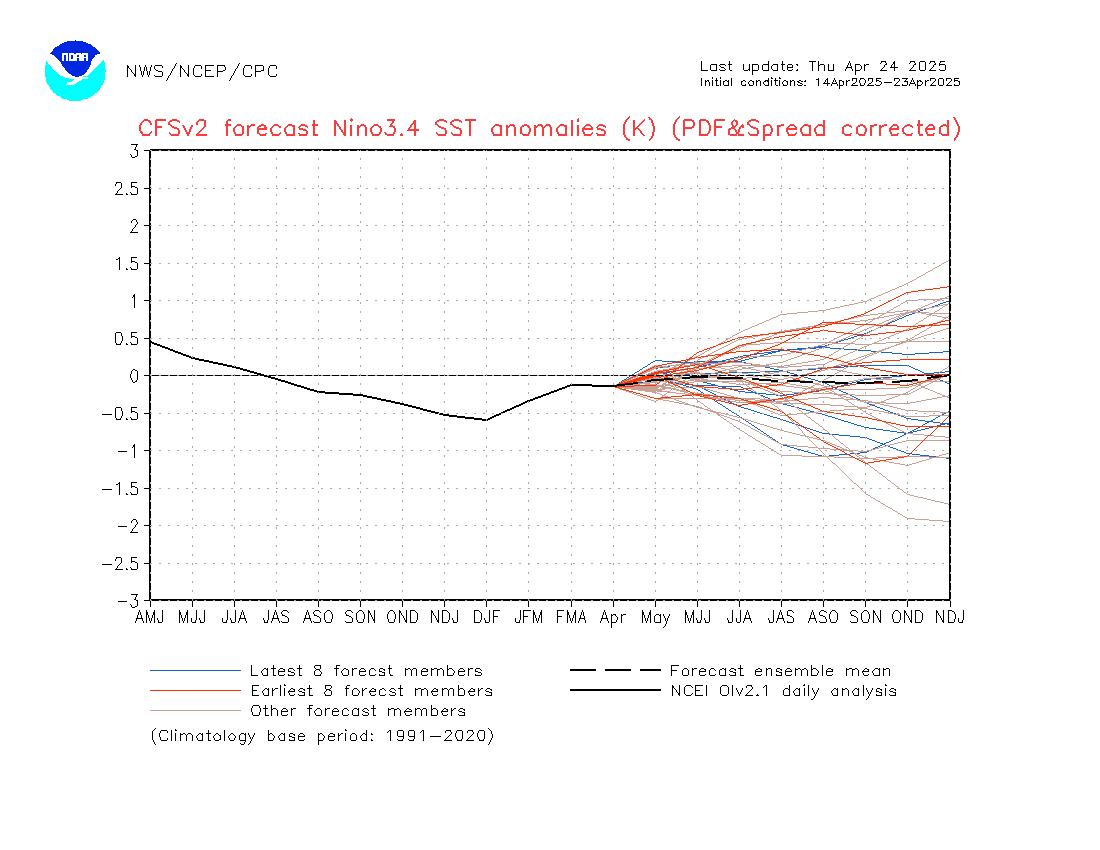
The above should auto-update. If it does not update you can click here https://www.cpc.ncep.noaa.gov/products/people/wwang/cfsv2fcst/images3/nino34SeaadjPDFSPRDC.gif This model shows La Nina continuing indefinitely. It has been showing that for some time but NOAA relies more on the IRI Forecast. But perhaps this model is now showing that we may become ENSO Neutral for next Spring.
Derived Versus from Actual Current Conditions.
NOAA reports some derived data that describes the current situation and a forecast. But what if we want to form our own opinion? After all, meteorologists are looking at the actual current situation and making predictions.
This shows the current actual situation.
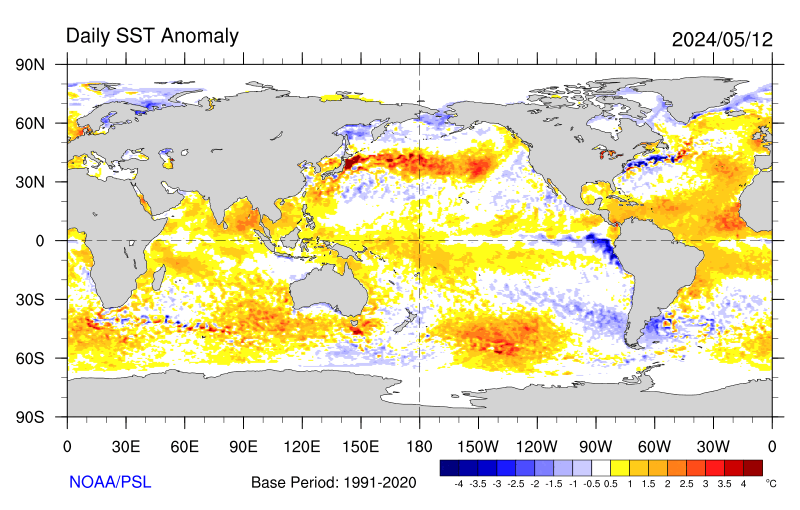
Where is ENSO Measured?
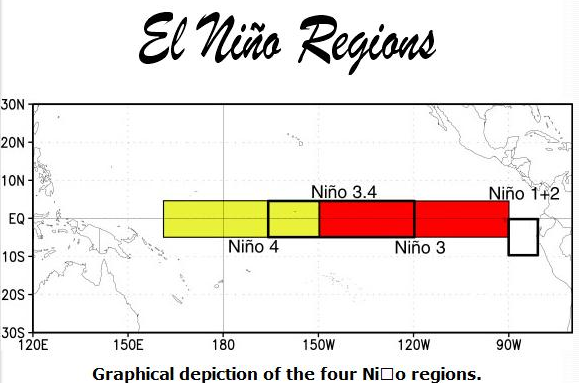
You can mentally superimpose the Nino 3.4 area shown encompassing part of the yellow and part of the red areas in the above map and you can see that it is cool in the Nino 3.4 area especially South of the Equator. That is an oddity of this La Nina that is both westerly displaced and focused mostly south of the Equator. There is not much discussion of that and how that might impact our weather.
One can also see that we remain in PDO-(Neg).
How About the Future?
ENSO is measured at the surface of the ocean because it is the surface that interacts with the atmosphere. But the surface changes over time so we pay a lot of attention to the subsurface. Here is what it looks like now. Does it look like it will soon be other than cool? It is complicated because we are looking at anomalies not absolute temperatures and we are only looking at a cross-section at the Equator when the Nino 3.4 Area extends five degrees north and south of the Equator but there is only so much information that can be presented in one graphic. Sea Surface Temperature Anomalies are only one component of ENSO but probably the most important component and La Nina is relative to SSTA is defined as -0.5C or colder.
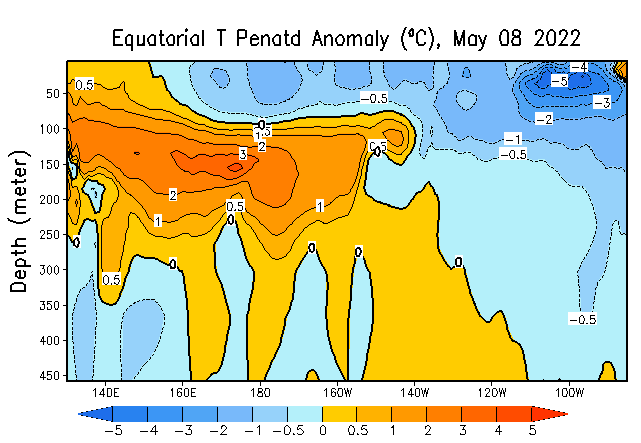
And last month at about this time in the month. The warm anomaly has actually advanced east a bit this past month.
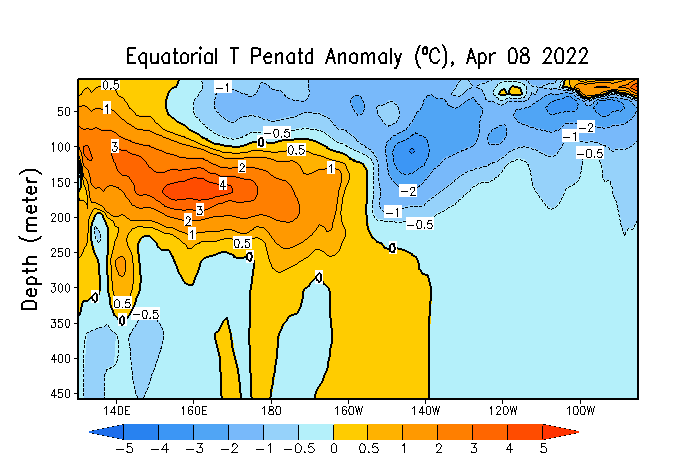
Here we are just looking at the Equator but from the surface down to 450 meters. And we are looking at the temperature anomalies. The Nino 3.4 Index is measured at the surface but the subsurface may become the future surface. There is anomalously cool water almost everywhere on the surface. Off to the west, the warm Indo-Pacific Warm Pool has receded from prior months but it is quite intense with maximum anomalies of 4 degrees Celsius. And we must remember that these anomalies are calculated based on the seasonal norms for water at that depth. So four degrees warmer than usual does not mean it is warmer than the water at the surface. So it will not automatically rise.
But let us look at the situation two months ago.
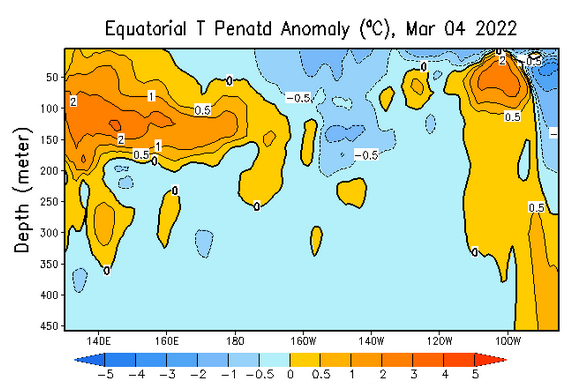
Last month it looked like the situation could quickly change. It does not look like that now.
I realize that is complicated. But it is important to understand. The analysis updates every five days but the graphics in this article are frozen. However, an updated version of this graphic can be found at https://www.cpc.ncep.noaa.gov/products/analysis_monitoring/ocean/weeklyenso_clim_81-10/wkteq_xz.gif. It comes with an upper graphic like the image shown above which is the temperature anomalies. It also has a lower graphic which is the actual water temperatures. Both are useful.
And this is what it looked like three months ago. There was a lot more warm water at depth but it is not there now.
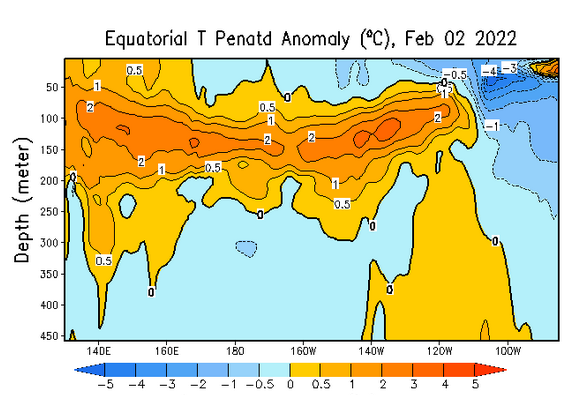
So in early January and early February, there had been a lot of progress in moving warmer water under the cool water and replacing it which explains the reduction of the intensity of the La Nina during those months. This suggested then that the IRI probabilities might be incorrect and the La Nina may be gone sooner rather than later. Now it looks like later rather than sooner.
Additional Information
Another way of looking at the situation is the impact of Oceanic Kelvin Waves.
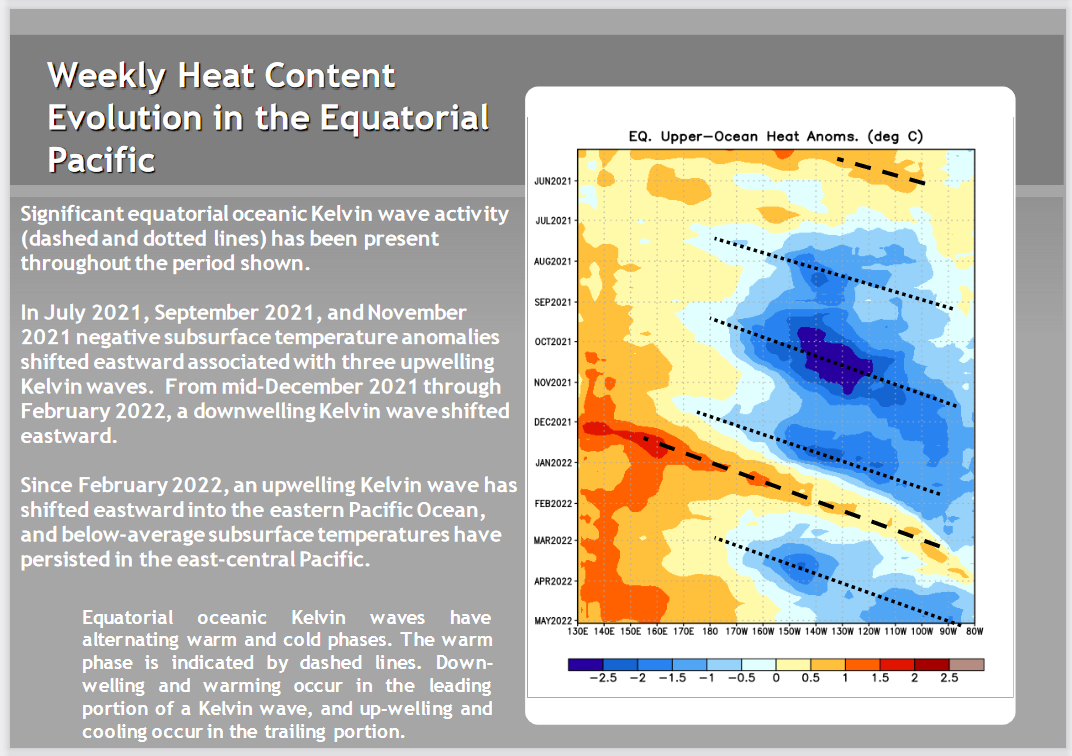
And a month ago.
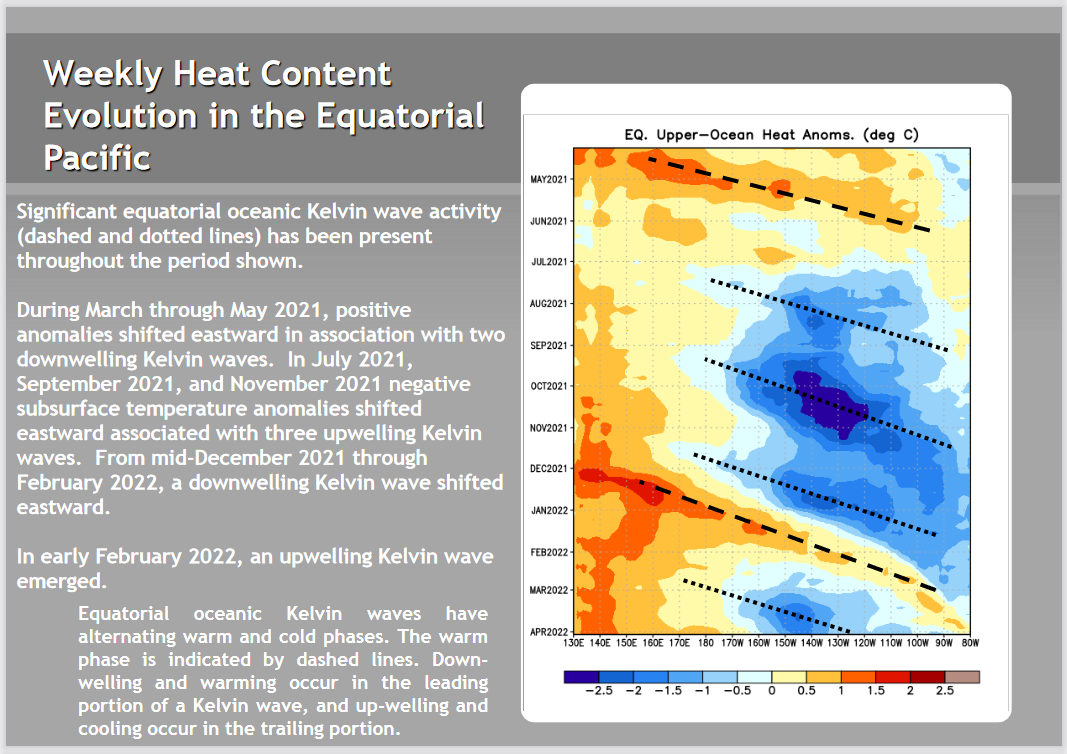
The above explains a lot.
We described Oceanic Kelvin Waves in the article last month but let’s just say they are near-surface waves confined to the Equator which can move warm water east and help end a La Nina. The downwelling phase of such a wave is shown in red and the upwelling phase is shown in blue. The recent Kelvin Wave made it look more likely that we would transfer to ENSO Neutral. But it turned out to be a fairly weak Kelvin Wave not followed by another one although we might see one forming in this graphic.
My conclusion is we do not know yet when this La Nina will be over if ever. I take that back, La Nina can not persist forever but there could be a Triple Dip which would cause a lot of problems.
What Are the Chances of a Three-Peat?
What does NOAA Say
We discussed that both two months ago and last month. But there was an interesting graphic and comment in the NOAA ENSO BLOG today which was written by Emily Becker. All La Ninas since 1950 which had a double-dip are shown. The black line is our current La Nina.
As you can see from the graph, April 2022 was the coldest of the nine second-year La Niña events on record, for this time of year.
This shows the average forecast for a group of models called the NMME. The shaded area is one standard deviation assuming the ensemble would form a normal distribution. So the shaded area is 68% of what would be a normal distribution and of that 68%, 61% is below the La Nina threshold. There are many other models and they would show different results. So this is not conclusive by any means but is certainly suggestive. It is presented in the Official Diagnostic Discussion at the beginning of this article as being what NOAA thinks at this point in time.
Since the confidence interval is one standard deviation I thought it might be nice to define one that means. Here is the formula.
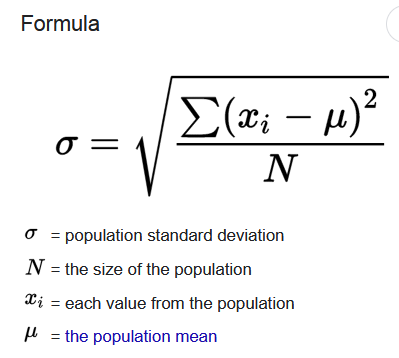
What do Other Meteorological Agencies Say
I do not have the time or resources to check what all of the various meteorological agencies have to say on this. NOAA publishes (or is it IRI) what they call a plume of forecasts from many models not just those operated by the U.S. Last month those models seemed to show that ENSO Neutral with a strong bias towards La Nina was most likely. By a strong bias, I mean the forecast was for Nino 3.4 to be in the lower end of the ENSO neutral range. But the updated version of this “plume” will be published with the second IRI report so I do not have it now. But I do have a report from the Australian Meteorological agency (BOM which shows a subset of models and I also have the JAMSTEC information. I will now show both sets of information.
BOM
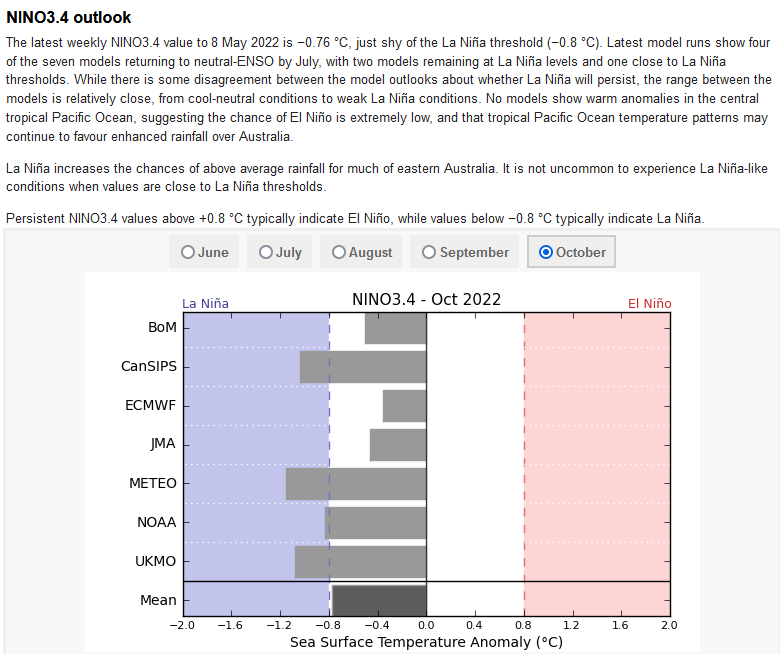
This just goes through October and it shows the BOM proprietary model back into neutral range by then but three models are still in La Nina range. The key is that they are talking about October and the information they provide only goes out that far. The ECMWF is a very well-respected model.
JAMSTEC
Here is what their Nino 3.4 model is forecasting.
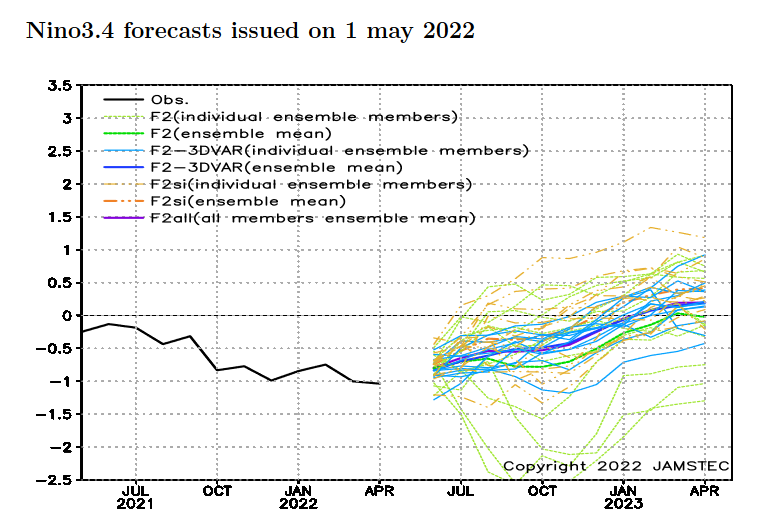
JAMSTEC sees ENSO going neutral in October.
But this is interesting.
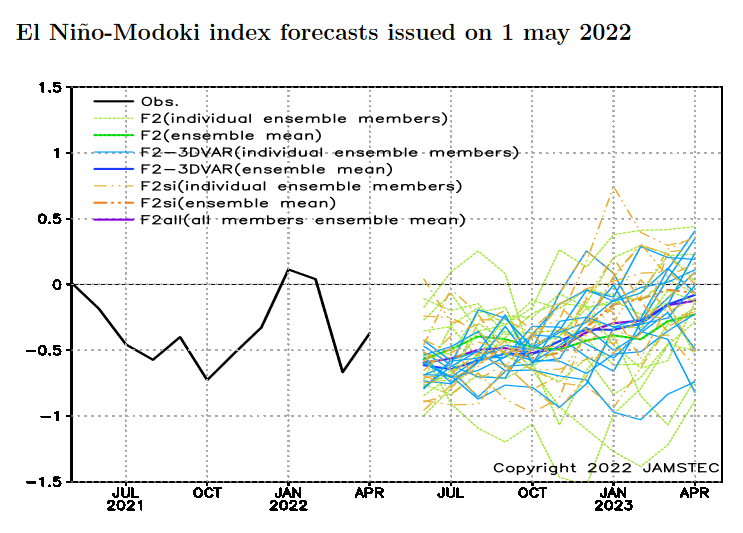
Their Modoki model also shows neutral by October but is less aggressive about moving to the total neutral line. So it maintains a La Nina bias into 2023.
So I conclude that the western displacement of this La Nina makes the forecasting more complicated and that is what we are seeing.
Impact of La Nina
I presented this information before. Here is the link https://www.cpc.ncep.noaa.gov/products/analysis_monitoring/ocean/weeklyenso_clim_81-10/wkteq_xz.gif
Here is the link to NOAA’s ENSO Blog and the current post by Emily Becker https://www.climate.gov/news-features/blogs/enso/may-2022-enso-update-piece-cake It is a good post but the title is silly You will find out what the title means if you read the blog post.
